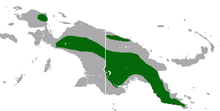| Black-tailed dasyure [1] | |
|---|---|
| Scientific classification | |
| Domain: | Eukaryota |
| Kingdom: | Animalia |
| Phylum: | Chordata |
| Class: | Mammalia |
| Infraclass: | Marsupialia |
| Order: | Dasyuromorphia |
| Family: | Dasyuridae |
| Subfamily: | Dasyurinae |
| Tribe: | Phascogalini |
| Genus: | Murexia |
| Species: | M. melanurus |
| Binomial name | |
| Murexia melanurus (Thomas, 1899) | |
 | |
| black-tailed dasyure range | |
| Synonyms | |
Murexechinus melanurus (Van Dyck, 2002) Contents | |
The black-tailed dasyure (Murexia melanurus) is a species of marsupial in the family Dasyuridae. [2] [4]
